NFT Painters and Their Impact on Digital Art
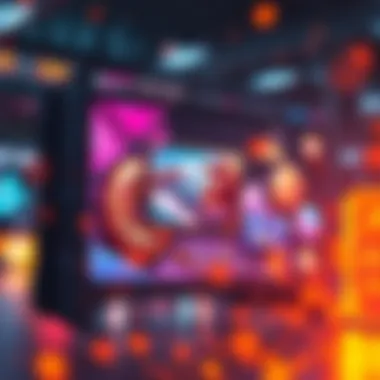

Intro
In recent years, the art world has been shaken to its core by the emergence of non-fungible tokens (NFTs). Artists are now pushing boundaries, not just with their creativity, but also with how they engage with the market. NFT painters, in particular, are using blockchain technology to present and sell their work in ways that were unthinkable just a decade ago. This article ventures into the transformative impact of NFT painters on the digital art landscape, breaking down the trends, ownership implications, and technical nuances that define this exciting new frontier.
Market Insights
The relationship between digital art and the cryptocurrency market is not merely incidental. As NFTs gain traction, they reflect wider currents in the cryptocurrency economy. Understanding these dynamics requires an in-depth look at both current trends and key indicators that can affect NFT painters.
Current Trends in Cryptocurrency Markets
The past few years have seen a rollercoaster of activity in cryptocurrency markets. With Bitcoin and Ethereum leading the charge, the recent enthusiasm around NFTs has contributed to a surge in trading volumes and overall market interest. Events such as the digital auction of Beeple's "Everydays" for $69 million have functioned like fireworks, lighting up global attention on NFT art.
Some of the noticeable trends include:
- Increased mainstream acceptance of cryptocurrency as both a payment method and investment vehicle.
- Growing support from major auction houses, galleries, and art institutions embracing NFTs.
- A rise in platforms dedicated to NFT creation and trading, from OpenSea to Rarible.
Key Indicators for Market Analysis
Identifying whether the NFT market stands on solid ground involves scrutinizing various indicators:
- Transaction Volume: Watch how many NFTs are sold and for what prices. High transaction volumes with stable or appreciating prices can signify a healthy market.
- Wallet Activity: Keep an eye on the number of active wallets involved in NFT transactions. Increased participation is often a sign of burgeoning interest.
- Market Sentiment: Social media buzz and discussions on platforms like Reddit or Twitter can provide insights into investor sentiment and upcoming trends.
The rise of NFT painters symbolizes a significant paradigm shift in the intersection of art and technology, illustrating that both creativity and investment can thrive in a digital space.
Blockchain Innovations
At the heart of the NFT craze lies blockchain technology, a decentralized ledger that guarantees transparency and authenticity for digital artists. This section discusses emerging technologies and their practical applications that are fostering growth within this unique marketplace.
Emerging Blockchain Technologies
Each day, new blockchain technologies come into play that offer better scalability, security, and efficiency for NFT transactions. A notable development is the emergence of Layer-2 solutions like Polygon, which allow for quicker transactions and lower fees compared to traditional Ethereum transactions.
Real-world Applications of Blockchain
- Provenance Tracking: Blockchain offers a foolproof way to establish authenticity and ownership history, fundamentally altering how art collectors view and value art.
- Smart Contracts: These are self-executing contracts with the terms directly written into code, allowing artists to earn royalties on resales—a capability not present in the traditional art market.
- Community Ownership Models: With platforms like Nifty Gateway or Foundation, artists can issue limited collections that allow fans to buy into the creative process, directly impacting its future development.
For a deeper understanding of the implications of these developments, consider visiting resources such as Wikipedia or Britannica for more structured insights on blockchain and its relation to art.
Preamble to NFT Painters
The rise of NFT painters has altered the digital art landscape in profound ways. Their significance lies in their capacity to redefine traditional concepts of ownership and authenticity in a world increasingly dictated by bytes and pixels. As technology advances, these artists are at the forefront of a movement that breaks down barriers, affording creators new avenues to monetize their work and engage audiences.
Definition of NFT Artists
NFT artists create artworks that reside on the blockchain, a decentralized ledger that records transactions securely. These artists transcend the conventional definitions associated with creator and consumer. Simply put, they breathe life into digital canvases—be it animated GIFs, 3D models, or styled images—transforming their creations into non-fungible tokens (NFTs). In contrast to fungible assets like cash or stocks that can be exchanged for one another, NFTs are unique and cannot be replaced. Their essence resides in the exclusive rights and provenance encoded within the blockchain.
This level of originality allows NFT painters to establish a distinctive identity in an oversaturated market. Whether they lean into surrealism or minimalist designs, each piece carries an inherent value—often reflected in its price. In doing so, NFT artists open themselves to a broad demographic of collectors, investors, and enthusiasts.
Brief History of Digital Art
Digital art’s trajectory, marked by innovation, started in the early 1960s with computer-generated graphics. Artists experimented with capturing their visions through code, and by the mid-1980s, the introduction of personal computers further democratized this emerging form of expression. Significant developments like Adobe Photoshop and platforms like DeviantArt advanced the medium’s popularity.
As we entered the 21st century, the adoption of the internet transformed how art was shared and consumed. Artists connected with audiences directly, bypassing galleries and auction houses. The establishment of social media platforms created opportunities for exposure, yet it also resulted in challenges, like copyright infringement. Amid this backdrop, the advent of blockchain technology in the late 2010s catalyzed the rise of NFT art. This not only solidified digital art’s legitimacy but also infused it with an economically viable framework.
In examining these components, one can appreciate the interplay between technological evolution and artistry. NFT painters have emerged not merely as creators but as pioneers navigating uncharted waters. Their role encapsulates not just artistic expression but also addresses the challenging economic landscape shaped by digital innovation.
The digital art world is no longer a shadow of its traditional counterpart—it has established its unique identity, driven by the functionalities of NFTs.
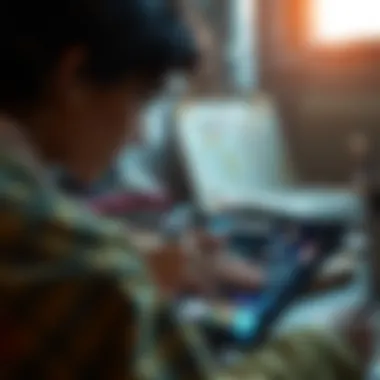

In summary, NFT painters stand as a crucial element in assessing the growth and future of digital art. They challenge prevailing notions of value, engage in dialogues about ownership, and catalyze transformative trends that resonate far beyond just aesthetic pleasure. Understanding their role elucidates the broader narrative of digital art's evolution, and sheds light on the potential directions it may take in years to come.
Understanding Non-Fungible Tokens
In the realm of digital art, Non-Fungible Tokens (NFTs) have emerged as a groundbreaking phenomenon, reshaping the ways artists create, distribute, and monetize their work. Understanding NFTs is crucial for grasping how they integrate with the digital art landscape, providing artists with new avenues for expression and income. This section delves into what NFTs are, the technology that supports them, and highlights key characteristics that set them apart from other digital assets.
What are NFTs?
At their core, NFTs represent unique digital assets verified through blockchain technology. Unlike cryptocurrencies such as Bitcoin or Ethereum, which are fungible and interchangeable, NFTs are distinct and cannot be exchanged on a one-to-one basis. Each NFT carries specific information that makes it one of a kind, encapsulating the ownership and authenticity of a digital art piece.
NFTs can represent various forms of digital content, from visuals to music and even virtual real estate. The nature of what they represent plays a significant role in how artists and collectors perceive value within the digital sphere. For NFT painters, it means that each piece they create is more than just an image; it's a verifiable representation of their artistic vision, forever anchored on the blockchain.
The Technology Behind NFTs
Blockchain Fundamentals
The foundation of NFTs lies in blockchain technology, a decentralized ledger that records transactions across multiple computers. This ensures that once data is logged, it cannot easily be altered or tampered with. For artists, the key characteristic of blockchain is its ability to provide proof of ownership. This transparency is a game changer in the art world, where authenticity has often been a gray area.
A unique feature of blockchain is that it allows artists to embed royalties into their NFTs, ensuring they receive compensation whenever their work is resold. This continuous revenue stream makes blockchain a beneficial choice for artists eager to maintain a connection to their work even after the initial sale. Yet, challenges like energy consumption and scalability could potentiall hinder widespread adoption.
Smart Contracts
Smart contracts are self-executing contracts with the terms of the agreement directly written into code. This technology paves the way for automated transactions, eliminating middlemen in the process. The key characteristic of smart contracts lies in their programmability; they adapt to ensure that both buyers and sellers fulfill their obligations. For NFT artists, this means they can set specific terms for sales, including royalties on future transactions.
One unique aspect of smart contracts is how they can enforce terms without reliance on external verification, thus minimizing the risk of fraud. This aspect is especially attractive for digital artists, as it grants them autonomy over their creations and mitigates the dangers of piracy. However, the complexity of coding can be daunting for some artists who may need assistance navigating this new terrain.
Interoperability
Interoperability refers to the ability of different blockchain systems to work together, enabling assets to be transferred seamlessly across platforms. One key characteristic is its potential to expand the reach of NFT artworks. Artists can list their creations on multiple marketplaces without hindrance, thus broadening their audience base.
This unique feature supports the idea of a diverse digital art ecosystem, allowing artists to engage with various communities while maximizing exposure. However, interoperability also presents challenges regarding standards, as not every blockchain system adheres to the same protocols. The varying frameworks could complicate transactions across platforms, leading to potential confusion.
"In the world of NFTs, the magic lies in the fusion of technology and creativity, allowing artists to reclaim ownership in an increasingly digital age."
In summary, understanding non-fungible tokens provides vital insight into the mechanics of the evolving digital art landscape. As each component works together—blockchain fundamentals, smart contracts, and interoperability—NFTs stand as a remarkable innovation, allowing artists to thrive in a space that has previously been fraught with uncertainty.
The Emergence of NFT Art
The emergence of NFT art marks a significant shift in how we perceive, create, and distribute art in the digital age. This moment is not just a trend; it's a transformation that bridges technology and creativity. With the rise of Non-Fungible Tokens, artists now have access to a platform that empowers them to preserve authenticity while showcasing their work to a global audience.
Artists often grapple with challenges regarding ownership and intellectual property, but the advent of NFTs provides a layer of security and validation that traditional formats lack. Unlike traditional art, where a piece can be easily replicated, NFTs offer a mechanism for certifying uniqueness.
First Movers in NFT Art
In the early days of NFT art, a handful of pioneers made waves that resonated throughout the art world. Artists such as Beeple, whose "Everydays: The First 5000 Days" fetched an astonishing $69 million at auction, showcased the potential financial and cultural impact of digital art as NFTs. These first movers paved the way for a surge of interest, inspiring countless creators to explore this novel medium. By positioning themselves as trailblazers, they not only demonstrated the viability of NFT art but also ignited conversations about ownership and value in the digital realm.
The Role of Marketplaces
Marketplaces are the lifeblood of the NFT ecosystem. They facilitate transactions between buyers and sellers, serving as platforms for artists to showcase their work while providing collectors with access to unique digital art pieces. The function of these marketplaces extends beyond mere transactions; they create vibrant communities where artists, collectors, and enthusiasts can interact and share ideas.
Leading NFT Marketplaces
When discussing leading NFT marketplaces, OpenSea often comes to mind, standing out due to its expansive selection and user-friendly interface. This platform not only allows artists to set up their own digital galleries but also offers features such as bidding and fixed price sales. One key characteristic that makes OpenSea a go-to choice for artists is its broad reach, attracting both new artists and established figures. However, it’s worth noting that the sheer volume of options can sometimes drown out lesser-known artists, presenting both an opportunity and a challenge.
Comparative Analysis of Platforms
A comparative analysis of platforms reveals intriguing distinctions among them. For example, Rarible is known for its community governance model, allowing users to participate in decision-making processes regarding platform changes. This characteristic draws in users who value engagement and community, setting it apart from competitors. However, due to its decentralized nature, some might find it challenging to navigate compared to more traditional marketplaces like Foundation, which is known for its curation process. This curation is beneficial for artists seeking visibility, but may limit access for emerging creatives. Overall, understanding these nuances helps potential NFT artists choose the right platform that aligns with their goals and expectations.
The Artist's Perspective
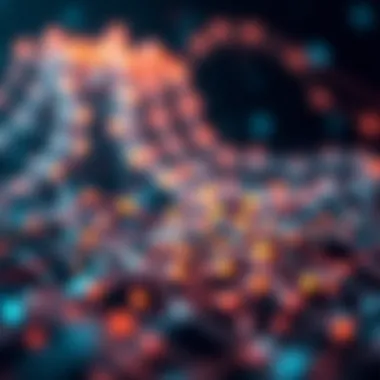
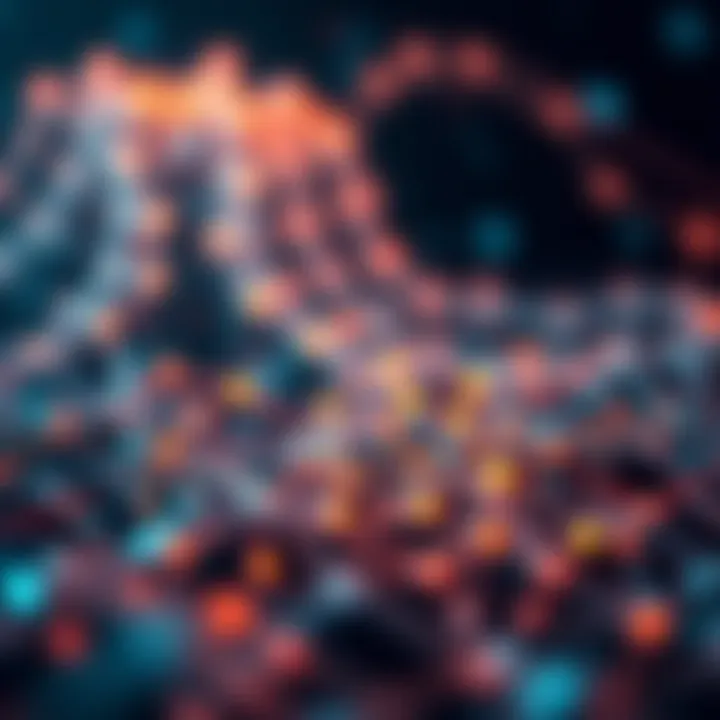
The perspective of artists working in the NFT world offers a unique vantage point on the dramatic shifts within the digital art landscape. These creators are at the heart of the transformation, experiencing firsthand the exhilarating freedom and daunting challenges that come with this new medium. NFT painters are not just selling art; they are participating in a history-making moment, reshaping how we perceive ownership, creativity, and artistic value in the digital age.
Creative Freedom and Ownership
NFT painters enjoy an unprecedented sense of creative freedom that was previously unthinkable. With the traditional art market often bound by gatekeepers—galleries, critics, and auctions—digital artists have been given a platform to showcase their work without restriction. This liberation allows for experimentation and innovation. Many artists have taken to the digital canvas, eager to push boundaries and explore new styles without the constraints of conventional art norms.
More importantly, ownership in the NFT realm also takes on a new meaning. Artists can now directly sell their works to collectors, retaining a percentage of future sales through smart contracts. This means that an artist can benefit financially from their work every time it changes hands. Unlike traditional methods where ownership often dissipates from the artist as the piece is sold on, NFTs allow for continual acknowledgement and financial support to creators.
Challenges Faced by NFT Artists
While the opportunities are bright, NFT artists also face a unique array of challenges.
Market Saturation
As NFT art continues to explode in popularity, market saturation has become a pressing issue. With so many artists entering the space, it becomes increasingly difficult for individual voices to stand out. The key characteristic of market saturation is that it creates intense competition, which can drive prices down and make it tough for artists to consistently find buyers for their work. For newer entrants, the sea of competing art can feel overwhelming, often leading to a sense of despair as they struggle for visibility in a crowded marketplace.
Despite these challenges, saturation brings about a certain level of diversity. The sheer volume of works can inspire collaboration and cross-pollination of ideas, resulting in innovative art forms born from various influences. Exit strategies for artists may involve finding niche markets or establishing strong personal brands that resonate with collectors.
Copyright and Plagiarism Issues
Another critical challenge for NFT artists lies in navigating copyright and plagiarism issues. As digital art becomes more accessible, instances of artwork being misused or replicated without permission have surged. This situation arises because, unlike physical art, NFTs often blur the lines of authenticity and originality. A creator might see their work copied and minted as an NFT by someone else, leaving them feeling exposed and powerless.
Moreover, the NFT market lacks a cohesive legal framework to address these violations. The unique feature of this challenge is its complexity; artists not only battle for recognition of their original works but also have to educate themselves about emerging laws related to digital ownership. For many, the legal intricacies can feel daunting. Understanding how to protect their rights and seeking recourse against infringers can be a steep learning curve.
Economic Implications of NFT Painting
The rise of NFTs has reshaped not only the art world but also the broader economic framework surrounding art transactions. In this section, we delve into the intricate ways that NFT painting influences financial dynamics in the digital art marketplace. Understanding these economic implications is vital for artists, collectors, and investors who are navigating this rapidly evolving landscape. The innovation of NFTs offers both new avenues for revenue and novel risks that can affect long-term value perceptions and investment strategies.
Monetization Strategies for Artists
NFT paintings provide a fresh landscape for artists searching for effective monetization methods. Unlike traditional art sales, where artists often see little return after the initial transaction, NFTs open a door to ongoing earnings through smart contracts.
- Royalties on Resales: One significant advantage is that artists can embed royalties within their NFTs. This means every time their art is resold, they receive a percentage of the sale. Such mechanisms encourage artists to create works with durability and can significantly boost revenue over time.
- Limited Editions: Many NFT artists opt to produce limited editions of their work. By creating urgency and scarcity, artists can command higher initial prices while fostering a sense of exclusivity among buyers.
- Crowdfunding Projects: Some artists leverage their NFTs as part of larger artistic projects, allowing fans to fund their creativity in exchange for ownership of unique pieces or future benefits. This strategy can help artists build a solid financial base from a community of backers eager to support their vision.
- Collaborative Works: Many artists are also exploring collaborative NFT projects with others in the community. These collaborations can attract broader audiences and diversify revenue streams as the collective value often exceeds what individual artists might achieve alone.
All these strategies reflect a shift in how art can be marketed and sold, moving beyond one-off transactions to sustainable models tied directly to the artist’s ongoing engagement with their work.
The Distinction Between Speculation and Value Creation
When discussing NFT paintings, one must discern between speculation and genuine value creation. This distinction is crucial for anyone looking to invest in the digital art market.
- Speculation: The NFT world often attracts speculative investors hoping to cash in on market trends. Prices can soar dramatically based on hype and celebrity endorsement, which doesn't always correspond to the intrinsic value of works. This creates volatility, leading to significant financial risks for investors seeking to profit off mere trends rather than deep-rooted appreciation of art.
- Value Creation: On the flip side, NFT paintings that contribute meaningfully to culture, or that embody innovation in art techniques, exhibit true value creation. A piece may not fetch astronomical prices in the short term but has the potential to appreciate based on its historical and contextual significance among collectors and future markets. Artists who maintain their integrity and focus on authentic storytelling create works that resonate and endure over time.
Understanding this dichotomy is vital for participants in the NFT art market, as it can guide informed decisions that align with either long-term investment strategies or quick-buck aims, depending on their goals.
"The distinction between speculation and value creation is crucial. Artists need to focus on building a narrative, fostering community, and establishing their market presence beyond just prices."
The economic implications of NFT painting reflect a shift toward a more artist-centric model that empowers creators and challenges traditional forms of ownership and valuation in the art marketplace.
Cultural Impact of NFTs on the Art World
The arrival of NFTs has stirred a pot that was already bubbling with change in the art world. Their introduction as a medium for artists to showcase and monetize their work has transformed not only how art is created but also how it is perceived. As the landscape shifts, the cultural significance of NFTs cannot be brushed aside. They open doors to discussions about ownership, authenticity, and the inclusiveness of artistic expression.
Shifts in Perception of Digital Art
Digital art has always been surrounded by some skepticism, often looked at as a lesser form compared to traditional media like paint and canvas. However, NFTs have given digital artists a platform to prove their mettle. No longer is digital art merely a collection of pixels; with NFTs, it gains a uniqueness tied to ownership. This evolution has altered the narrative around digital art. Individuals now view it through a lens of potential investment and value.
A clear indication of this change can be seen in how collectors approach purchases. They once might have turned their noses up at a high-resolution digital artwork, but now, with the ability to own that piece as an NFT, the perspective has shifted tremendously. High-profile sales, like Pak's "Merge" or Beeple's "Everydays: The First 5000 Days," underline this transformation, showcasing that digital art can command significant sums, thus elevating its status.
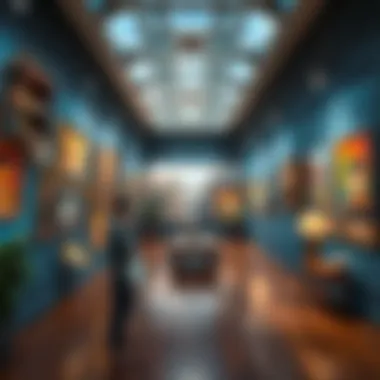

In terms of demography, the current wave of art collectors isn't just made of the old guard. Younger, tech-savvy individuals are joining the fray. They see NFTs not merely as collectibles but as cultural artifacts of a digital age. In essence, that shift is not just about accepting digital art; it's about redefining what art means in our society.
NFTs and Traditional Art Institutions
The relationship between NFTs and traditional art institutions is complex and often fraught with tension. Traditional galleries and auction houses are not sure how to integrate these digital assets into their existing frameworks. A large portion of the art world relies on physical spaces and established reputations, which NFTs seem to undermine. Yet, institutions are starting to wake up and smell the coffee. Increasingly, museums and auction houses are beginning to feature NFT exhibitions and sales, indicating their growing acceptance.
Some institutions see this as a threat to the longstanding practices of art curation and appreciation, while others view it as an opportunity to innovate. A prime example is Christie’s auction house, which famously sold a digital artwork as an NFT, signaling the merging of classical art and modern technology. This kind of embrace by reputable institutions suggests a reconciliation of sorts, as they grapple with this new form of art.
However, there’s still a lingering question: Can NFTs coexist with traditional art? The answer seems to reside in the value of accessibility. NFTs can democratize the art market, allowing more artists to gain visibility without relying solely on traditional gatekeepers. Overall, the cultural impact of NFTs on the art world is profound and multifaceted, provoking both uproar and innovation as everyone tries to keep pace with this paradigm shift.
The Future of NFT Painters
The terrain of the art world is shifting beneath our feet, and NFT painters are at the forefront of this evolution. As we peer into the crystal ball, it becomes clear that the future of NFT painting is intertwined with technological advancements and societal acceptance of digital art. Understanding this landscape is crucial for artists, collectors, and investors alike, as it shapes not only the market dynamics but also influences how creativity is perceived in the contemporary age.
One significant element promising to reshape the role of NFT painters is the ongoing development of decentralized platforms. These platforms are built on the principles of blockchain, ensuring transparency and security in transactions. As trust in these systems grows, more artists might feel encouraged to experiment with NFT paintings. This shift points towards increased diversity in artistic expression and possibly even a rise in unconventional styles that could disrupt traditional art norms.
Furthermore, artists are exploring monetization strategies that leverage the unique benefits of NFTs. From royalties on secondary sales to exclusive content for collectors, the potential avenues for income generation seem boundless. Artists and investors who recognize this shift can align themselves with a movement that not only promotes creativity but also fosters a more direct connection between the creator and the consumer.
"The only way to do great work is to love what you do." - Steve Jobs
This quote sums up the vital importance of passion in any artistic endeavor, and in the realm of NFTs, where authenticity reigns supreme, this sentiment carries even more weight. As NFT painters navigate through both the opportunities and challenges ahead, their commitment to their craft will be fundamental in setting the tone for what comes next in this digital renaissance.
Predicted Trends in NFT Art
As we move forward, a few trends are set to surface that could heavily influence the trajectory of NFT art over the coming years. For starters, collaborations between artists and AI could become common. With tools that blend human creativity with algorithmic efficiency, the artistic output could lead to new styles or movements that we have yet to see. The interplay between human intuition and computational prowess may come to define a distinct branch of NFT art.
Additionally, traditional art institutions may increasingly embrace NFTs. Galleries and museums could begin to curate shows featuring digital artworks, and perhaps even establishing dedicated sections for NFT art within their spaces. This would provide a more established platform for NFT painters and help legitimize the medium in the eyes of general audiences.
- Sustainability Concerns: The environmental impact of blockchain technology is being closely scrutinized. As discussions around sustainability grow, NFT artists may need to adapt by seeking eco-friendlier platforms or engaging in more green practices in their art production.
- Global Accessibility: The beauty of NFTs lies in their capacity to make art accessible far beyond local markets. Artists from underrepresented regions may finally find a voice through NFTs, reaching collectors worldwide and broadening the diversity of perspectives in art.
Potential Integration with Other Technologies
The integration of NFT painting with emergent technologies stands to not only enhance artists' experiences but also reshape how audiences engage with digital art.
Augmented Reality
Augmented Reality (AR) represents an interesting aspect of the future landscape for NFT painters. Through AR, digital art can be superimposed onto the physical world, allowing collectors to view their digital assets in their real environments. This immersive experience offers a dynamic way of interacting with art that was previously unattainable. The key characteristic here is the personalization aspect; when an artwork can be displayed in one’s living room via an app, it cultivates a closer connection between the collector and the art piece.
However, there are challenges to consider. Not everyone possesses the technology or know-how to use AR effectively. Furthermore, there may be concerns regarding the authenticity of displayed NFT art when it enters the realm of physical observation, but this hinders rather than halts innovation in the space.
Virtual Galleries
The concept of Virtual Galleries also presents profound implications for NFT painters. These galleries create opportunities for exhibitions that transcend geographical boundaries. Artists can host virtual shows that anyone, anywhere can attend without the constraints of time or space. Furthermore, a unique feature of virtual galleries is that they can integrate interactive elements, like allowing viewers to communicate directly with the artists or explore the creative process behind pieces exhibited.
On the downside, some audiences may still prefer the tactile experience of physical galleries. Digital-only showcases might miss out on those who root themselves deeply in traditional art experiences. Nevertheless, as technology evolves, it seems more likely that a hybrid approach could emerge, converging the best of both worlds.
In summary, NFT painters are heading into a future where creativity is empowered, experiences are enriched by technological advancements, and the art world becomes ever more decentralized. For investors, art enthusiasts, and artists alike, the choices and tools available will determine the direction of NFT art in the years to come.
Ending
In the rapidly changing paradigm of digital art, the role of NFT painters is gaining spotlight and significance. Understanding the implications of NFTs in the art world is not just an academic pursuit; it offers essential insights for artists, collectors, and anyone invested in the ongoing development of digital creativity. This article has journeyed through various facets of NFT painting, shedding light on several key elements.
Synthesizing Insights on NFT Painting
The emergence of NFT technology has redefined ownership and authenticity within the realm of art. For painters and artists, gateways to selling their work to global audiences have widened, due to digital platforms such as OpenSea and Rarible. These marketplaces are not just mere conduits for buying and selling art; they carry the potential for artists to retain royalties on future sales, a novel concept in traditional art markets.
Furthermore, the technological backbone of NFTs, primarily based on blockchain, ensures that each piece is distinctly verifiable, setting a solid foundation for community trust. The authenticity backed by smart contracts represents a significant shift in safeguarding artistic rights. This means that artists are better equipped than ever before to navigate the legalities surrounding their works. Additionally, it’s essential to address the challenges faced by NFT artists, such as market saturation. As creators flood the market, distinguishing one's work becomes a vital practice.
Final Thoughts on the Future Landscape
Looking ahead, what will be the fate of NFT painters? As virtual reality and augmented reality technologies become increasingly dominant, artists are likely to explore these mediums further. Integrating interactive elements into their works could transpire into a new sub-genre within NFT art. This suggests a fertile ground for more profound immersion and viewer engagement.
Moreover, as traditional art institutions continue grappling with the digital shift, one might see the birth of hybrid models that merge physical presence with the limitless capabilities of digital spaces. Institutions embracing NFTs can create dynamic galleries that preserve the history while adapting to the evolving tastes of modern audiences. There is a bright yet unpredictable horizon. The blend of creativity, technology, and commerce stands to inform the landscape meaningfully.
In essence, NFT painters are not merely players in a trendy playground. They are reshaping the definitions and perceptions of what art can be in our digital age, fostering dialogues that echo far beyond pixelated canvases.







